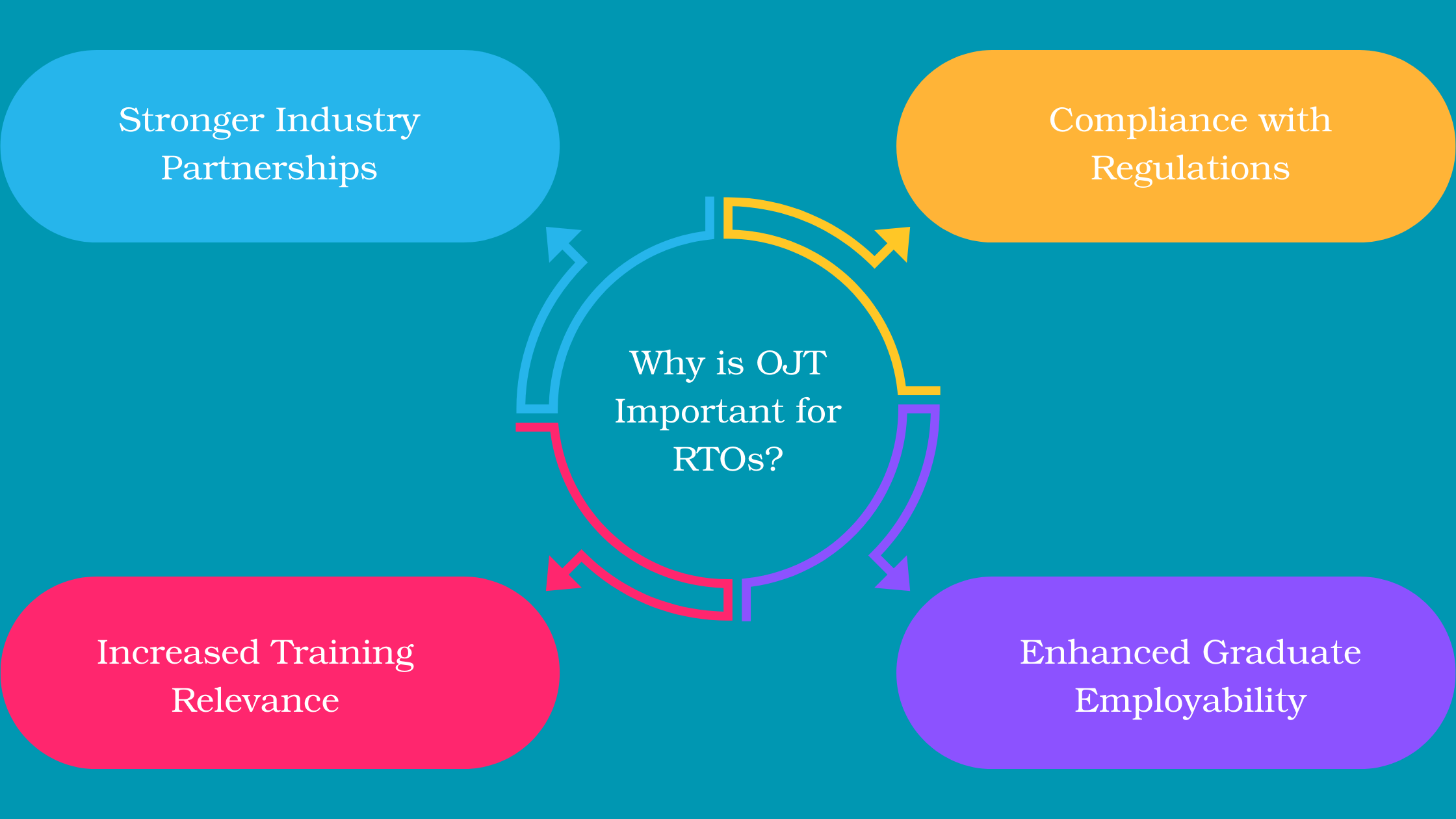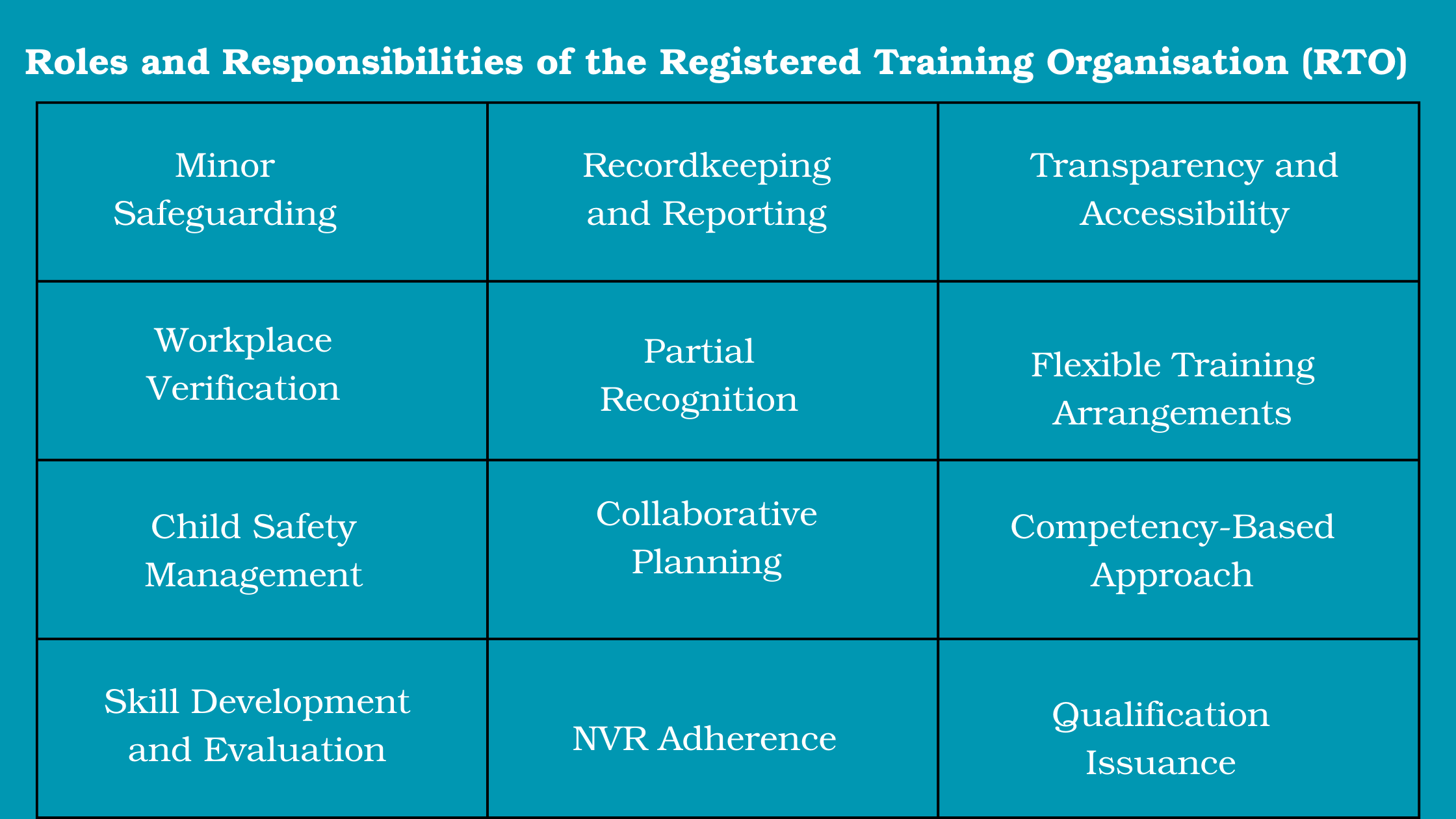How can you ensure your students and graduates are ready for the ever changing job market?
Through on the job training.
Today, in this blog we will explain
- on job training
- types of on the job training
- Examples of on the job training
- Roles and Responsibilities of RTO
and much more. So, let’s begin.
What is On the Job Training?
On the Job Training, also known as job training or OJT training, provides students with hands-on experience in a real-world work environment under the guidance of experienced professionals. It’s like taking the classroom to the workplace, allowing students to apply their theoretical knowledge to practical scenarios and develop essential job skills.
Why is OJT Important for RTOs?

On the Job Training offers a multitude of benefits for RTOs:
- Enhanced Graduate Employability: Graduates with OJT experience are more attractive to employers. They’re seen as job-ready and possess the practical skills needed to hit the ground running. This translates to higher graduate employment rates and improved graduate outcomes, a key performance indicator for RTOs.
- Increased Training Relevance: OJT ensures your training programs stay relevant to current industry needs. By integrating real-world scenarios and industry practices, you’re equipping students with the skills and knowledge employers actually value. This leads to more satisfied graduates and employers, further strengthening your reputation.
- Stronger Industry Partnerships: Collaborating with employers on OJT placements fosters valuable relationships. You gain insights into industry trends and skill requirements, allowing you to tailor your training programs accordingly. This creates a win-win situation: RTOs stay relevant, and employers receive a pipeline of skilled graduates.
- Compliance with Regulations: The Australian Standards for Registered Training Organisations (2015) emphasise the importance of workplace learning. OJT demonstrates your commitment to meeting these requirements and showcases the high quality of your training programs.
Benefits for Your Graduates
- Practical Skills Development: On job training provides students with the opportunity to apply their theoretical knowledge to real-world situations. They develop essential job skills, boost their confidence, and become more efficient in their chosen field.
- Networking Opportunities: OJT placements expose students to industry professionals and potential employers. They build their professional network, increasing their chances of securing permanent employment after graduation.
- Competitive Edge in the Job Market: Graduates with OJT experience stand out from the crowd. They’re seen as adaptable, eager to learn, and ready to contribute from day one. This gives them a significant advantage in the competitive job market.
| Key Considerations | |
| Quality Placements | Partner with reputable employers who offer valuable learning experiences and provide adequate supervision for your students. |
| Balanced Curriculum | Integrate OJT with classroom learning to ensure a comprehensive training program that covers both theory and practice. |
| Targeted Approach | Focus OJT placements on industries where practical skills are essential, such as trades, hospitality, and healthcare. |
Table 1: What should be the key considerations for RTOs to make OJT a success
Types of On the Job Training

As an RTO committed to equipping your students with the skills needed for success, offering on-the-job training (OJT) can be a valuable addition to your curriculum. But with two primary approaches – structured and unstructured – deciding which best suits your program and students can be a strategic decision.
Unstructured On the Job Training
- Key Features:
- No set training agenda: Learning happens organically through observation and hands-on experience alongside experienced colleagues.
- Trainer selection: Coworkers act as mentors, choosing tasks and activities based on immediate needs and trainee progress.
- Best suited for:
- Limited job roles: Tasks are well-defined and consistent, requiring minimal specialised skills.
- Examples: Medical receptionists, machinery maintenance workers, and retail associates.
- Advantages:
- Flexible and adaptable: Caters to diverse skill levels and workplace dynamics.
- Minimal planning: Quick to implement and adjust.
- Immersive learning: Provides immediate real-world experience.
- Disadvantages:
- Inconsistent quality: Training may vary depending on the chosen mentor and their expertise.
- Lack of structure: Can lead to gaps in skill development and difficulty tracking progress.
- Unpredictable outcomes: Effectiveness relies heavily on individual mentorship quality.
Structured On the Job Training
- Key Features:
- Well-defined training agenda: Tasks, instructions, and timelines are clearly outlined, ensuring consistent learning across trainees.
- Standardised approach: All trainees for a specific role follow the same training program, regardless of individual mentors.
- Best suited for:
- Complex skills and knowledge: Requires a systematic approach to ensure thorough competency.
- Examples: Call center staff, sales teams, specific trade skills.
- Advantages:
- Increased effectiveness: Guarantees comprehensive skill development and prepares trainees for diverse scenarios.
- Improved accountability: Clear roadmap tracks progress and fosters responsibility in both trainees and trainers.
- Consistent quality: Standardised training ensures consistent skill levels across all trainees.
- Disadvantages:
- Requires significant planning and resources: Upfront investment in curriculum development and trainer training is necessary.
- Less flexible: Adapting to individual needs or workplace changes can be challenging.
- Less immersive: May feel less dynamic compared to unstructured OJT.
Choosing the Right Approach
The ideal OJT approach for your RTO program depends on several factors:
- Complexity of skills and knowledge: Structured OJT is better suited for intricate fields requiring a comprehensive learning path.
- Student needs and learning styles: Consider individual preferences for structure and flexibility.
- Industry requirements and expectations: Align your OJT approach with the practices and standards of your target industry.
- Program resources and budget: Structured OJT demands more upfront investment in planning and resources.
| Feature | Structured OJT | Unstructured OJT |
| Training Agenda | Well-defined with tasks, instructions, and timelines | No set agenda; learning through observation and hands-on experience |
| Trainer Selection | Standardized for each job role | Coworkers act as mentors, choosing tasks and activities |
| Best Suited For | Complex skills and knowledge | Limited job roles with well-defined tasks |
| Examples | Call center staff, sales teams, specific trades | Medical receptionists, machinery maintenance workers, retail associates |
| Advantages | Increased effectiveness, accountability, consistent quality | Flexibility, minimal planning, immersive learning environment |
| Disadvantages | Requires significant planning, less flexible, less immersive | Inconsistent quality, potential gaps in skill development, unpredictable outcomes |
Roles and Responsibilities of the Registered Training Organisation (RTO)

As an RTO, you play a pivotal role in facilitating successful traineeships and equipping individuals with the skills and knowledge needed to excel in their chosen fields. Your responsibilities encompass a broad spectrum, ensuring a positive and productive learning experience for both trainees and employers. Here’s a breakdown of your key roles:
Training and Assessment:
- Collaborative Planning: In consultation with the employer, you develop a comprehensive training plan, outlining the training modules, assessments, and expected learning outcomes for the trainee.
- Transparency and Accessibility: You provide copies of the training plan to both the employer and trainee, ensuring clear communication and shared understanding of the learning journey.
- Skill Development and Evaluation: You deliver formal training and assessment activities aligned with the traineeship requirements, utilizing diverse methods to cater to various learning styles and effectively gauge acquired knowledge and skills.
- Recordkeeping and Reporting: You maintain accurate training attendance records and readily provide them to employers upon request, facilitating smooth communication and record keeping.
- Competency-Based Approach: You ensure the traineeship adheres to a competency-based framework, guaranteeing that trainees achieve mastery of essential skills and knowledge needed for success in their chosen field.
- Workplace Verification: You maintain regular dialogue with the employer to confirm workplace competence, bridging the gap between theoretical learning and practical application.
- Flexible Training Arrangements: You strive to offer flexible training options that accommodate the needs of both trainees and employers, maximising opportunities for successful completion.
Certification and Recognition:
- Qualification Issuance: Upon successful completion of the traineeship and fulfillment of all AQF requirements, you issue trainees with certificates for their attained qualifications, officially recognising their achievements.
- Partial Recognition: For trainees who may not complete the entire qualification, you provide statements of attainment, acknowledging the skills and knowledge they have acquired through their coursework.
Compliance and Regulatory Oversight:
- NVR Adherence: You diligently conduct all RTO operations in accordance with the strict standards of registration outlined by the National VET Regulator (NVR), ensuring high-quality training and ethical practices.
- Minor Safeguarding: For trainees under the age of 18, you require a co-signed training contract from a parent or guardian, upholding a commitment to providing a safe and supportive learning environment.
- Child Safety Management: You proactively implement measures to ensure a child-safe environment for all trainees under 18, adhering to relevant legislation and policies.
On the Job Training: Practical Examples for Your RTO
As an RTO, equipping your students with effective on-the-job training (OJT) experiences is crucial for preparing them for career success. While the theoretical foundations are essential, it’s the practical application of knowledge that truly sets your graduates apart. Here are some diverse examples of OJT approaches you can consider incorporating into your programs:
Direct Supervision:
- Coaching/Mentorship: This method pairs trainees with seasoned managers or team leaders who provide constant guidance and constructive feedback. Trainees learn firsthand through observation and practical experience, receiving immediate support and tailored advice.
Exploration and Observation:
- Internships: These immersive placements offer students invaluable exposure to the realities of a chosen field. While internships may include some observation, they often involve structured tasks and projects that allow trainees to test their theoretical knowledge and develop practical skills under supervision.
- Buddy System: This peer-to-peer approach assigns trainees to experienced colleagues at the same level. By shadowing their daily routines and observing how tasks are tackled, trainees gain practical insights and learn from relatable role models.
Active Learning and Engagement:
- Job Shadowing/Observation: This method allows trainees to accompany experienced workers throughout their workday, observing their workflow, decision-making processes, and interactions with colleagues and clients. While active participation may be limited, the insights gained are invaluable for future application.
- Job Rotation/Stretch Assignments: By temporarily placing individuals in different roles or departments, this approach broadens their skillset and provides exposure to diverse tasks and challenges. Buddy or mentor support can further enhance the learning experience.
Technology-Enhanced Learning:
- eLearning: Online training modules offer flexibility and accessibility, allowing trainees to complement their OJT experiences with targeted digital learning. Concise, focused modules can be tailored to specific skills and seamlessly integrated into daily routines, maximising efficiency and knowledge retention.
Conclusion
As a Registered Training Organisation (RTO), your commitment to equipping students with the skills and knowledge needed for success extends beyond the classroom walls. On-the-job training (OJT) emerges as a powerful tool for bridging the gap between theory and practice, preparing graduates for real-world challenges and maximising their employability.
This journey begins with understanding the diverse landscape of OJT methods, choosing approaches that best align with your program’s objectives, student needs, and industry expectations. Structured OJT offers a well-defined roadmap for skills development, while unstructured OJT provides flexibility and fosters adaptability. Both, when strategically implemented, can contribute significantly to the learning process.
Beyond the choice of method, collaboration and partnership are key to successful OJT. Building strong relationships with employers allows you to tailor training programs to their specific requirements and provide valuable workplace experiences for your students. Engaging experienced mentors and coaches within companies further strengthens the learning environment, ensuring students receive the guidance and support they need to thrive.
By investing in OJT, you are not simply preparing graduates for their first job; you are empowering them with the confidence and competence to navigate their entire careers. The practical skills, industry connections, and adaptability they gain through OJT become invaluable assets, setting them apart in the competitive job market and paving the way for a successful and fulfilling future.
Want more
Frequently Asked Questions
What types of jobs are eligible for OJT?
OJT focuses on positions with strong industry growth, offering graduates lasting career opportunities and continued employment. This ensures your training equips them for jobs with real-world demand.
Do students need to find their own OJT placements?
Ideally, you want students to take initiative and actively search for relevant OJT opportunities aligned with their career goals. However, your cooperative education program can support their search by providing approved training sites and offering guidance throughout the process.
Disclaimer:
The information presented on the VET Resources blog is for general guidance only. While we strive for accuracy, we cannot guarantee the completeness or timeliness of the information. VET Resources is not responsible for any errors or omissions, or for the results obtained from the use of this information. Always consult a professional for advice tailored to your circumstances.






